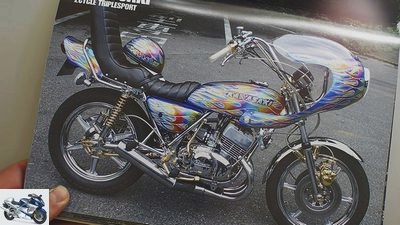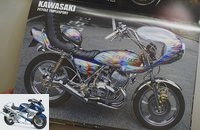Menus

Sven Wedemeyer
Scene: Customs scene in Japan
Big in Japan
Content of
On the other side of our planet, the world is not upside down. But she is different. Let’s just try to understand the customs scene in Japan, between Wakkanai and Nagasaki.
D.he common continental Europeans thinks islands, well … nice. On Rugen, Sylt or Malle, he likes to hold his pale paunch in the sun for a few weeks and wear the latest sandals in tennis socks. But soon a vague discomfort sets in on the island. Quite so, so the troubled sea wanted to drown the whole pile of earth in its foaming spray. British, Icelanders or Jamaicans, we are somehow suspicious of them. If an island like Japan is a fourteen-hour flight away on another continent, then our understanding of the indigenous people there is not far off.
Buy complete article

Scene: Customs scene in Japan
Big in Japan
One of the most creative custom scenes in the world
With this knowledge you can quickly see that the Japanese two-wheeler subculture is also something special for the European-trained eye. The country may not offer the largest, but on closer inspection one of the most creative custom scenes in the world. It’s also home to the big four – Honda, Kawasaki, Suzuki and Yamaha. The dominant manufacturers have turned the world market upside down over the past few decades. Japan has been setting the tone since the CB 750 Four at the latest, even if Hamamatsu or Minato have been a little quieter in recent years. But don’t worry. In the home market and neighboring countries, the Yamaha R 25 and Kawasaki’s little ninja are still selling like sliced bread.
In addition to the everyday-oriented scooter and motorcycle riders, there is a diverse microcosm that unites converters, tuners, motor sports enthusiasts and all those who feel at home between vintage and heritage. As with us, this includes a good shot of individualism, self-expression and living out unorthodox lifestyles in an over-regulated environment. Those who go to school in uniform are happy to later distance themselves from the conformism of society. Nothing new, one would think.
In contrast to American or European roads, Japanese roads are dominated by small machines. State-imposed cubic capacity limits mean that icons such as the Yamaha SR 400 or the balloon-tyred TW 200 fun mobile are absolute long-running hits in Nippon’s screwdriver garages. But because the foreign beckons forever, foreign products also play a major role in the scene. Despite their proximity to the nucleus of the modern two-wheeler industry, bikes from Harley, Triumph, Ducati and Moto Guzzi are extremely popular classics.
After years of economic stagnation, the scene has inevitably rearranged itself. Here are the Japanese small displacement spaces – affordable, simple, practical. There the old, large-volume rubbish from Good Old Europe or America, which is more suitable for higher earners. Both trends have in common that they often work with maximum effort down to the smallest detail, taking advantage of all technical possibilities. Because Japanese culture regards even things as animated. The more fine details a bike has, the greater the chance of a transcendental experience in its saddle. An optimized and individualized motorcycle sets itself apart from the uninspired crowd that is always overwhelmingly present in major Japanese cities. Elaborately converted shovelheads, long-legged Yamahas or classic Triumph bobbers can often be seen in the streets, unlike ours. Because the Japanese really move their motorcycle. He drives. More than many European collectors would ever dare to.
The list of important makers in Japan is long
Again, the Japanese are increasingly emulating the European style, which in their eyes is defined by Cafe Racer, Bobber and the Brat Style. The latter in particular is exciting because “Brat Style” was initially just a motorcycle shop in Tokyo. Owner Go Takamine established a striking line with its ultra-flat single-cylinder conversions, which eventually became a symbol of an entire genre. Clean, reduced and deprived of most of the spring travel, the Brat Style trend spilled over the oceans like a tsunami. In Japan itself you still don’t want to believe that.
So they are influential, the Japanese. For example Kengo Kimura, the head of Heiwa Motorcycles, an incredibly productive store in Hiroshima, which feels like unleashing new motorcycles at the public every second. His bikes are simple, classic and indulge in the less-is-more principle. Kaichiroh Kurosu from Cherry’s Company is driven by other ideals. In Tokyo, he conjures up drivable, one-offs out of old two-cylinders, which must be seen as shimmering highlights of the national scene. Cherry’s converted Harley XG 750, for example, is based on a spectacular chassis that gives the turbo twin a nice frame. What looks like show and shine works so well that Cherry can seriously attack with the XG on the racetrack. A blatant custom bike that works really well despite massively changed technology is not a matter of course in the rest of the world. In Japan, however, it is.
The list of important makers goes on and on. Chicara Nagata is one of the country’s elite. In many thousands of hours he builds works of art on two wheels, which can bring him the title of AMD World Champion of Custom Bike Design. His creations, more sculptures than motorcycles, are sold for horrific sums to the super-rich. Colleague Shinya Kimura, who lives in California but does not deny his Asian roots, does the same.
And Shiro Nakajima, the man behind Ritmo Sereno and 46 Works, must also be mentioned. Because the great love for European classics and historic motorsport is manifested in his vehicles. Shiro’s redesigned KTM underpins this in an exemplary manner. A real hit, this largely stripped RC8. Nakajima-San proves that performance, dynamism and sensible sportiness are enthroned above the sex appeal that most Japanese conversions unquestionably exude. Because in addition to extravagant design and innovative lines, the focus is always on driving. In Japanese culture, a functionally robbed object – like an inoperable motorcycle – is only worth half as much. So the motorcycle always remains a practical vehicle, even as a long-lasting extreme chopper.
Master of Emergence
In cities like Tokyo, where the subculture of free-thinking custom bikers is most likely to be accepted and car parks mutate into party locations at night, motorcycling rarely makes sense. Far away from smog, traffic jams and narrow streets, many Japanese meet on the mountainous roads of the hinterland. Or bring their wild treasures to shows or small racetracks that are spread across the country. Exhibitions, track days and club races shape the scene. They support the exchange, which in addition to the digital world always has a personal touch. A strict upbringing and the high value of togetherness in everyday Japanese life are having an effect.
What makes Japan a creative hotspot for highly independent motorcycles is the result of various circumstances. Despite the similarly strict specifications as we know them from the German TÜV, unconditional perfectionism, limitless inspiration and a good dose of modesty are responsible for the fact that Japanese creations are technically and aesthetically exceptional. Here, more than anywhere else, it is possible, through the interplay of many small elements, to create an arrangement that rises above the sum of its parts. This is called emergence. The Japanese are obviously masters in this discipline.
Related articles
-
Rise and Fall of the Japan Chopper
Herzog 44 pictures Reuter 1/44 1980 Yamaha XS 650 US Custom. Archive 2/44 1980 Suzuki GSX 1100 L. Frank Herzog 3/44 1981 Yamaha XV 750.Archive 4/44 1980 …
-
Scene: Brough Superior 8-75 SS 100
Nakamura Scene: Brough Superior 8/75 SS 100 The big hammer Content of Can a 1000 cc motorcycle that only runs 100 mph be worth a whopping 200,000 euros?…
-
Comparison test of naked bikes from Japan
Art 15 pictures Art 1/15 Art 2/15 Art 3/15 Art 4/15 Art 5/15 Art 6/15 Art 7/15 Art 8/15 Art 9/15 Art 10/15 …
-
News from Japan Speculation In autumn there will be motorcycle innovations. Reliable information, hard facts. The time before, the time of dreams and …
-
BMW R nineT Custom Bikes from Japan
BMW 22 pictures BMW 1/22 From left to right: Shiro Nakajima (Fa. 46 Works), Hideya Togashi (Fa. HIDE Motorcycle), Go Takamine (Fa. Brat Style) and …
-
Honda CBR 400 R (2020): Revised entry-level athlete for Japan
Honda. 5 pictures Honda. 1/5 Honda has presented a new model with the CBR 400 R. Honda. 2/5 The beginner athlete is only used in …
-
Scene: Hildebrand & Wolfmuller replica
Bilski scene: Hildebrand Wolfmuller replica The first to the second content by Hildebrand Wolfmuller are considered the first motorcycles to be built in series …
-
BMW Willoughby 65 from VTR Customs (2018)
Sven Wedemeyer 15 pictures Sven Wedemeyer 1/15 impressions of the BMW Willoughby 65 from VTR Customs. Sven Wedemeyer 2/15 Satisfied smile: Marcello has …
-
SCENE: Thailand – Custom Honda
Henniges SCENE: Thailand – Custom-Honda Proud Loud content from On Thailand’s largest island Koh Samui, FUEL discovers a few quirky …
-
Wolf Scene: Honda CB 450 Police Highway – too fast Content of American Nightmare? Encounter of the miraculous kind? A US police machine brand …